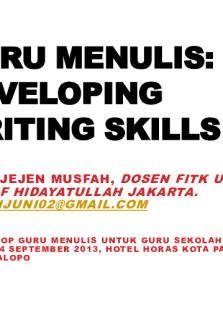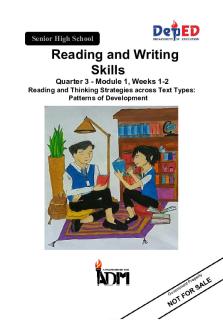Reading and Writing Skills - The Context of Text Development PDF

| Title | Reading and Writing Skills - The Context of Text Development |
|---|---|
| Course | reading and writing skills |
| Institution | Tagum City National High School |
| Pages | 3 |
| File Size | 62.8 KB |
| File Type | |
| Total Downloads | 266 |
| Total Views | 748 |
Summary
Download Reading and Writing Skills - The Context of Text Development PDF
Description
Reading and Writing Skills Quarter 4 – Module 4: The Context of Text Development
To understand the concept better, it is good to define some important terminologies in the study of context and text development. Context – the parts of a discourse that surround a word or passage and can throw light on its meaning. The interrelated conditions in which something exists or occurs. Hypertext – non-linear way of showing information. It connects topics on a screen to related information, graphics, videos, and music.
Intertextuality – connections between language, images, characters, themes or subject.
What is a Context? There is always an inspiration behind the writing of a text, and often, it leaves clues about the situation or the reality that served as the backdrop of the text. This backdrop, this situation, this reality is known as the context of the text.
Context is similarly defined as the social, cultural, political, historical, and other related circumstances that surround the text and form the terms from which it can be better understood and evaluated.
When you consider context as you write things, be guided by the following reminders:
• In writing non-fiction like academic texts, historical narratives, argumentative essays, position papers, etc., you need to stick to the facts. Reveal reality as it is. To do so, conducting extensive research using scholarly references is a requisite. •
When using context, try to represent several perspectives by citing different sources.
• If you are writing fiction and aim to integrate your context into it, remember to not make the tale too far off from human and worldly reality. Works like Harry Potter, the Lord of the Rings, and Ibong Adarna, while they are fictional, have a lot of the human touch in them—making them relevant to audiences.
What is Text Development? There are several ways by which a text is developed. You learned in junior high school about the different forms of essays such as descriptive, narrative, expository, and argumentative. In this module, you will learn about the other forms that fall under expository texts. Each form has its own way of developing the text, but here are the essentials that you need to remember:
Being a critical reader also involves understanding that texts are always developed in a certain context. A text and its meaning and understanding are affected by a given set of circumstances. Knowledge of the text’s context helps in appreciating the text’s message more deeply. In determining a reading context, you may consider when the work was written, the circumstances it produced, and the issues that deal with it.
In analyzing the context of text development, one needs an in- depth knowledge of these two techniques: hypertext and intertextuality.
Hypertext Innovation of technology brings recent developments in reading. Let’s take a look at the technological advancements that you’re familiar with. Choose those that you actually have as possessions.
Perhaps you have owned most of these. If you did and you read texts through the said gadgets, you may have noticed that some web pages have texts that have hyperlinks. It is a link from a hypertext file or document to another location or file, typically activated by clicking on a highlighted word or image on the screen that is normally underlined in blue color.
What Hypertext Is Hypertext is a nonlinear way of showing information. It connects topics on a screen to related information, graphics, videos, and music. It mainly appears on the "Internet" or the "World Wide Web," where highlighted words or buttons will lead the user to any of a wide possibility of new sites related to the text to which it is linked. This new site will have, most likely, several links in it as well. The World Wide Web is comprised of a vast number of "linked" sites, all of which are examples of hypertext. Hypertext leads the reader to jump to get more information about a topic freely from one part to another depending on what aspect of the text interests him, which in turn may have more links. This opens him to a broader perspective of information or to a new direction.
In reading with hypertext, the reader is given more suppleness and personalization because he gets to select the order in which he reads the text and focus on information that is relevant to his background and interests. Consequently, he can create his own meaning out of the material. For example, you are doing a research about the COVID-19 virus. A quick Google search would lead you to a Wikipedia article on it.
Information on it would include an image and a brief, written description. While reading about the information from its very minute detail, you will also encounter links to its preventive measures. This may lead you to more information about how to prevent from acquiring such dreaded disease. However, if you were interested in the statics of the death cases of COVID-19 because you want to get informed of its statistical data, the same page would provide you its statistics and even give you links to pictures and videos. Thus, depending on your purpose and interests, the article on COVID-19 could lead you to a multiplicity of different, detailed paths.
Hypertext has three main pedagogical benefits provided by incorporating it in a writing class:
1.
Hypertext promotes discourse.
2. Hypertext can be made as a concerted medium, and it makes possible forms of collaboration that emphasize the social construction of the meaning. 3.
Hypertext can be used in nearly any computer-facilitated classroom.
Hypertext is unique and distinctive. It helps the reader shift from one text to different texts speedily. When the first text mentions the concept that is also discussed in another text, the other page will load by clicking its hyperlink.
What Happens when We Shift to Different Texts? One good thing that hypertext does is allowing readers to shift to different web pages almost instantly. When you get to navigate around the internet and view several web pages in a matter of seconds or minutes, you have a greater chance of getting a better picture of the entire scenario in a fast manner. When you read a news article – especially one that belongs to a series – you will see hyperlinks that will bring you to other related news stories. This helps the reader get a better understanding of the whole story....
Similar Free PDFs

2 - Context and CO-TEXT
- 9 Pages

Text, Context and Cognitive Metaphor
- 15 Pages

Writing Skills
- 29 Pages

Reading Skills
- 4 Pages

Reading and Writing (1-20)
- 44 Pages
Popular Institutions
- Tinajero National High School - Annex
- Politeknik Caltex Riau
- Yokohama City University
- SGT University
- University of Al-Qadisiyah
- Divine Word College of Vigan
- Techniek College Rotterdam
- Universidade de Santiago
- Universiti Teknologi MARA Cawangan Johor Kampus Pasir Gudang
- Poltekkes Kemenkes Yogyakarta
- Baguio City National High School
- Colegio san marcos
- preparatoria uno
- Centro de Bachillerato Tecnológico Industrial y de Servicios No. 107
- Dalian Maritime University
- Quang Trung Secondary School
- Colegio Tecnológico en Informática
- Corporación Regional de Educación Superior
- Grupo CEDVA
- Dar Al Uloom University
- Centro de Estudios Preuniversitarios de la Universidad Nacional de Ingeniería
- 上智大学
- Aakash International School, Nuna Majara
- San Felipe Neri Catholic School
- Kang Chiao International School - New Taipei City
- Misamis Occidental National High School
- Institución Educativa Escuela Normal Juan Ladrilleros
- Kolehiyo ng Pantukan
- Batanes State College
- Instituto Continental
- Sekolah Menengah Kejuruan Kesehatan Kaltara (Tarakan)
- Colegio de La Inmaculada Concepcion - Cebu










